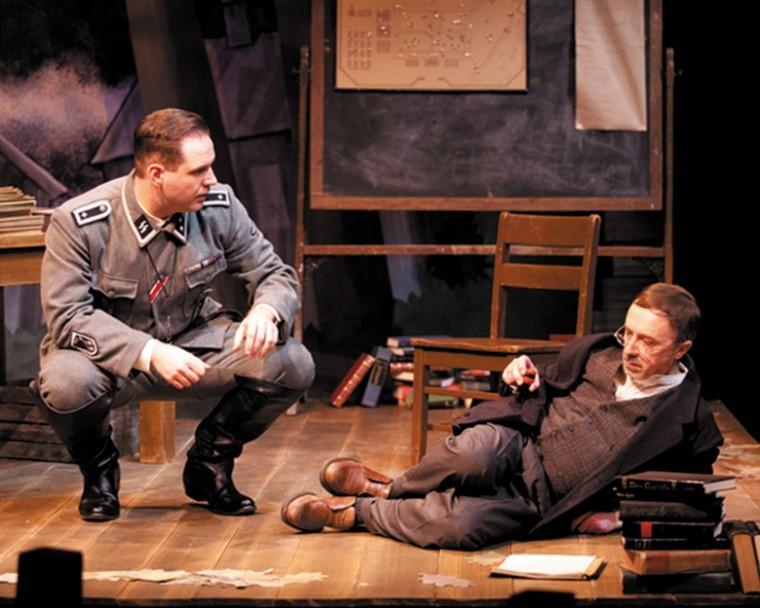‘Way to Heaven’ paved with good intentions
Published February 8, 2012
It has been said that the road to hell is paved with good intentions. And that seems to be true of the “Way to Heaven” by Spanish playwright Juan Mayorga, which will run through Sunday at the New Jewish Theatre.
Jewish Light critic Robert Cohn has already reviewed the NJT’s production. I have been galvanized to add my something because on the evening of Feb. 3, I attended the panel discussion, which was mulling over the question: “Can art illuminate life?” The discussion was hosted by the NJT and moderated by Batya Abramson-Goldstein, executive director of the Jewish Community Relations Council.
I guess ART! means it is true to a vision or a message, unlike entertainment which is motivated by what sells most and best. But when we saw the “The Last Night at Ballyhoo” at the NJT, was that entertainment — because we laughed? And is “Way to Heaven” ART!-because…we hardly laughed, if at all? Reasonable people will concede that it is hard to draw the line between art and entertainment. Also tricky is differentiating between art and propaganda, especially if the artist has incorporated a lie, but is on our side.
Months ago, when St. “Jouish” was engaged in a series of discussions about “The Death of Klinghoffer” (the opera performed by Opera Theater of St. Louis) because it might be construed as anti-Jewish, we were also talking about ART! But the extreme case: Adolf Hitler was an avid art collector. It might be a mistake to think that honoring ART! might be on a par with serving God.
In the 1966 film, “A Man and A Woman,” the man and the woman agree that if there were a fire and you had a choice between saving a Rembrandt or a cat, you would save the cat. Life is real in a way that ART! isn’t.
Because of a technical snafu the night of the panel discussion, it was hard to hear the participants and the moderator. Nevertheless, I think some of the panelists, like the play itself, lost sight of what’s important. One of the panelists was Gad Guterman, the NJT’s dramaturge, who wrote in his synopsis for the playbill, “[Mayorga] erases distance from events and from peoples and insists that the past is very much still palpable.” Because in that ARTistic description, I recognize neither the play nor the past, I find it chillingly detached.
“Way to Heaven” opens with a monologue by a former Red Cross investigator who has returned to the site of the Nazi concentration camp that he had visited decades earlier. In subsequent scenes, several sets of boys have the same conversation about a spin-top and a naked sister; a man talks to alternating wives about the future; and a pathetic girl seems to flub lines spoken to her rag doll. But eventually, the puzzle pieces fall into place and a play within a play emerges-a detailed charade planned by the camp’s Commandant for the Red Cross visitor to conceal the Jews’ true situation.
The playwright was inspired by an actual, 1944, Red Cross visit to Theresienstadt, a concentration camp sited at an army garrison in Terezin in present-day Czechoslovakia. Unlike the camp in the play, Theresienstadt had no death machinery. But because of starvation, disease or ill-treatment, thousands died there. When the Red Cross visited, things were spruced up and the investigators gave a favorable report.
The play’s fictional camp is in Germany, it has a crematorium and the Red Cross visited in 1941. The major betrayal of history is that either to avoid soiling the Fatherland, or to hide the gas chambers and crematoria, the Nazis did not put any in Germany.
But more importantly, what is the point of the plot and most of the dialogue? The charade! The Red Cross representative’s colossal mistake is not seeing through it. The Jews are kept alive rather than sent to the crematorium because of it. And the Commandant’s primary role is as the producer of the charade. At the Nuremberg trials, Nazi war criminals were convicted of crimes against the peace, crimes against humanity and genocide. With one exception (as Dan Reich, curator of the St. Louis Holocaust Museum and Learning Center, noted), they were not tried and convicted of propaganda.
But in the ghettos, concentration camps, labor camps or death camps, the common denominator was that the Jews had been severed from their lives. Their personal property had been confiscated. They had lost their livelihoods, their homes, their school careers, their hobbies, their communities, their synagogues and one another.
During the evening of the panel discussion, more than one person said that by the time of the Red Cross visit, the world already knew what was happening. That would be hard to quantify about the real world in 1944 and even more so about the fictional world of “Way to Heaven.” But regardless, the playwright misses an essential point. It was the job of the Red Cross (in the play and historically) to fire a report around the world: It’s shockingly true, the Jews have been rounded up and violated with the loss of all civil rights (and if the Germans have given themselves permission to do this what else will they do?). The deception with the spin-top and the conversation about the future is obscenely trivial.
“Can Art illuminate Life?” We can get caught up in ART! and lose sight of what is meaningful and true.















